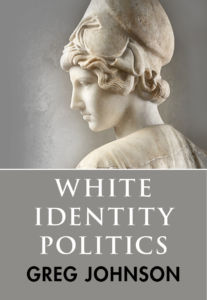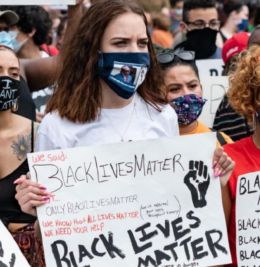Black Lives Matter Diary
Seeing the fuss being made about the death of George Floyd in May 2020, and gathering that it was if anything being depicted as worse than it actually was on social media, I started keeping a “Black Lives Matter diary” to record subsequent events and my thoughts about them. Two years later, having concluded the diary, I edited it to make it more readable and, dreaming that it might one day be published, wrote an introduction. This began by saying that I hoped that people might find the diary interesting, since my comments were the fruit of long experience of black people and years spent thinking about racial politics. It might therefore contain insights that go a little deeper than some that had been offered. It continues as follows.
Editing the diary brought out for me some of the main things that occurred in this period, such as the extension and coming out into the open of anti-white discrimination by both blacks and whites, expressions of hatred of whites by both blacks and whites, and attacks on white institutions, ways, and products by both blacks and whites. This is why I describe what went on as a race war, but a dual one in which whites were attacked not only by black people but also by themselves. Not that the war only started when George Floyd died; it had been going on for 50 years by then, but his death — or rather the publicity it received — certainly heated it up. Yet I heard no one describe it as a race war, let alone one possessing this dual character. The nearest people got, if they called it a war, was to call it a culture war. This is because white people prefer not to employ the concept of race, which means that most commentators missed the essence of the situation.

You can buy Greg Johnson’s White Identity Politics here.
Another prominent theme was that of white replacement. Whether it was white characters being played by black actors, the ancient Romans being depicted as black in children’s books, or white writers being dropped from school and university curricula in favour of black writers, examples came up all the time. White replacement is definitely not just a matter of demographics.
Going back through the diary I was also struck by the sheer dishonesty of a great deal that was said about “black history,” as for example concerning the length of time black people have been in Britain and the contributions they have made to our national life. Black people made no contribution to our national life before the 1950s if only because there were never more than a handful here, nor did anyone point to a positive contribution they had made more recently. Instead, dreadful lies were told about supposed white misbehaviour to blacks over the centuries. An atmosphere of deception surrounds the whole period, and indeed, the whole war.
But what was most notable was that in all the time covered by the diary, no one pointed to a case of a black person being mistreated by a white person on account of his race. This seemed to be the kind of thing to which protestors imagined that they were objecting, yet it did not occur. Even in the case of George Floyd, no police officer thought, “This guy’s black, let’s get him!” Rather, they thought, “This is the guy we’re supposed to arrest,” whereupon George Floyd resisted. Even if Derek Chauvin killed him, which seems debatable, there is no reason to think that he acted as he did because Floyd was black. On the other hand, white people and anything associated with them were attacked every day, again by black and white alike, only because they were white.
Why did white people think that black people were suffering at their hands when it was not the case? The immediate cause was that the media, aiding Black Lives Matter, suggested it, and the diary points out how they did this. To sum it up, rarely did they make the claim in as many words. Generally, they put the idea into the air using vague, emotive language, especially the terms “racism” and “racial inequality.” What this racism might be was rarely specified, nor was it generally possible to say in what respect the races were being said to be unequal. But few asked. Instead, their conditioned reaction to the words took them straight to outrage and indignation.
What in fact the media were usually referring to by “inequality” was not inequality of treatment, but inequality of circumstance, which was held against whites on the assumption of a yet third application of the concept of equality, namely innate racial equality: the idea that the races are in themselves the same. If the races are in themselves the same, their circumstances should be the same, but they are not; therefore, black people must be being oppressed by whites. This was the reasoning suggested by the media, to which the public were encouraged to respond by giving money to Black Lives Matter and affording black people even more special treatment than they were already receiving, amid confessions of guilt and demonstrations of personal and racial self-abasement.
In short, the BLM phenomenon was a con, but in this it was nothing new. It only showed us once again the standard anti-racist method being used to achieve the standard anti-racist aim: false accusations against white people aimed at making them feel so guilty that they will give black people what they do not deserve.
Nor does a white person or institution need to be naïve to become a victim of this strategy, for we are all bound by the taboo against mentioning racial differences. Thus, whenever blacks want more from whites, they point to differences between the races’ circumstances, daring whites to explain them in terms of differences between their natures. Thanks to the taboo, whites cannot do this, so they must instead produce false confessions of their alleged misbehavior and pay the recompense demanded, with the addition of a hint of a threat of violence.
This extortion racket has characterized racial politics for more than 40 years. Why change a strategy that never fails?
The repeated use of this strategy helps to explain the contempt felt by many blacks for whites. So consistently and for so long have blacks been pandered to, told that they are to be pitied, and treated as a special case that they have acquired the mentality of spoilt children, determined to get ever more out of their despised “parents” who, full of unjustified feelings of guilt, rush to oblige them at no matter what cost to themselves. But as the diary suggests, white people wish to pay this cost. Only a deep masochism can explain the dual nature of this race war.
Finally, it may be wondered why the diary rarely mentions Asians, specifically those from the Indian subcontinent. Except in one affair concerning cricket, Asians had little to do with what went on. The main roles in this flare-up of the race war were, as usual, played by blacks and whites, with blacks the supposedly aggrieved party — in fact, really the principal aggressors — and whites the supposed aggressors but the real victims, again of their own self-destructiveness as well as the destructiveness of blacks.
* * *
Like all journals of dissident ideas, Counter-Currents depends on the support of readers like you. Help us compete with the censors of the Left and the violent accelerationists of the Right with a donation today. (The easiest way to help is with an e-check donation. All you need is your checkbook.)
For other ways to donate, click here.



